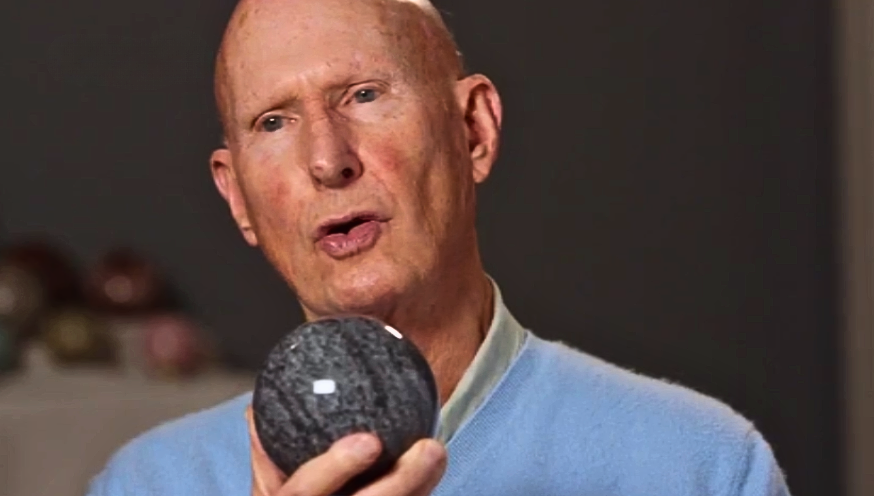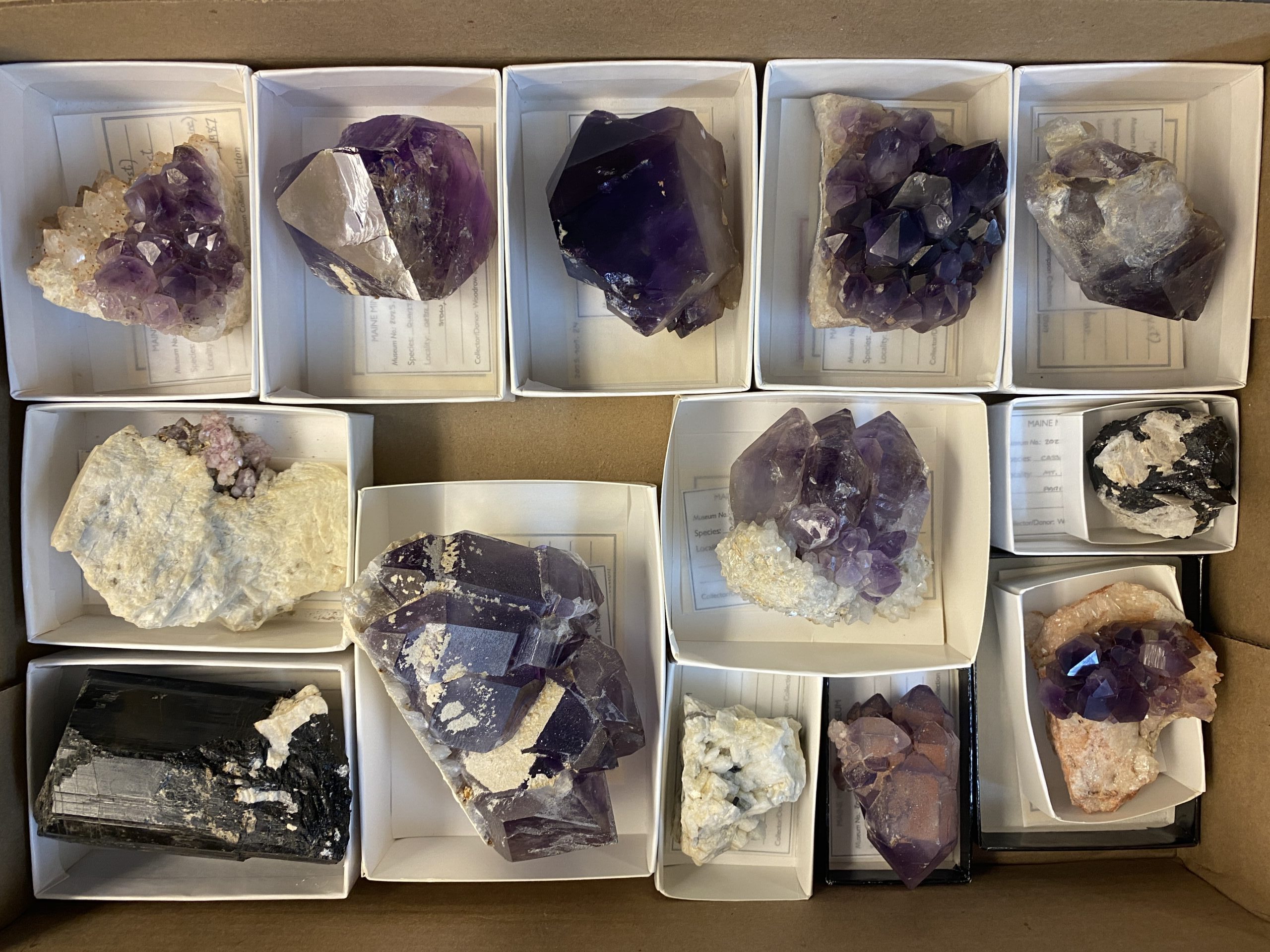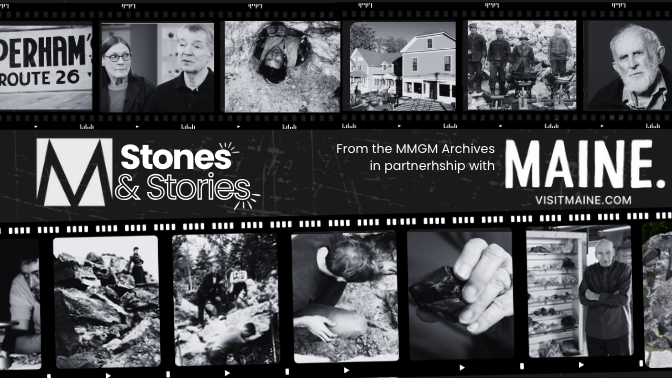The Maine Mineral & Gem Museum mourns the passing of Dr. Robert “Bob” Ritchie, M.D., a founding trustee, pioneering rheumatologist and researcher, and master lapidary artist whose life bridged science, craftsmanship, and an enduring love of Maine’s — and the world’s — rocks and minerals. Dr. Ritchie died on October 5, 2025.
Bob Ritchie was a man of firsts. He was the first rheumatologist to practice in Maine, the first to write a comprehensive book on the art and science of cutting stone spheres, and one of the first to envision preserving Maine’s geological legacy through what would become the Maine Mineral & Gem Museum — alongside museum founder Lawrence T.P. Stifler, Ph.D.
He may also have been the first person ever to bring a lapidary machine aboard an active Navy destroyer during his four years of service in the early 1950s — though that one’s harder to verify.
As a founding trustee, Ritchie’s lasting imprint on the museum is evident.
The Robert F. Ritchie Lapidary Studio at MMGM bears his name and carries on his craft, continuing the “rare art,” as Ritchie called it, of sphere cutting and sharing it with the community.
“Dr. Ritchie was a founding MMGM Board member. His expertise and contacts in the field proved invaluable in establishing the museum’s reputation and collections,” said Lawrence Stifler, Ph.D., founder of the Maine Mineral & Gem Museum, reflecting on Ritchie’s contributions. “He introduced MMGM to the unique art form of sphere making and wrote the only book available on the subject. His legacy will live on at this museum, both through his extensive collection of spheres that he donated to the permanent collection and through the MMGM Robert F. Ritchie Lapidary Studio, a hands-on educational space created to facilitate various forms of stone-related arts.”
Ritchie’s lifelong fascination with stones began when he was a boy. In a 2022 MMGM newsletter, he recalled that it wasn’t the geysers of Yellowstone that captured his imagination, but the drive home where he noticed “every little town after little town had gem and rock shops.”
When he returned home, the teenage Ritchie sketched a sphere he had seen and showed it to his high-school shop teacher.
“He said, ‘Let’s make one.’ And so we did.”
That small experiment became the start of a lifetime’s devotion to sphere cutting and the lapidary arts. By high school, he was already cutting stones for a New York gem importer.
“I was obsessed,” he admitted in past interviews.
Even military service couldn’t interrupt the habit.
“I had a little lapidary machine and asked permission to bring it on board,” he recalled in a 2015 interview for MMGM’s Maine Voices oral history project. “I cut stones in my spare time on the North Atlantic patrol.”
After returning from the Navy, Ritchie earned his medical degree from the University of Rochester and completed postgraduate training at Boston’s Brigham Hospital. Upon coming to Maine as an intern, he soon established the state’s first rheumatology practice.
His work in medicine would cause him to put his lapidary machine away for 40 years, but his precision and perseverance as a physician mirrored the patience that would later define his stonework. In 2003, as he was winding down his research career, he returned to the craft that had never truly left his soul.
“I’ve been having a ball — so to speak — since,” he recounted more than 10 years — and 900 spheres — later. “It’s a wonderful hobby. Keeps me occupied. Keeps me stimulated.”
From his small home workshop came nearly a thousand hand-cut lapidary spheres. Ritchie worked meticulously, measuring each piece at every step. He developed techniques to achieve a tolerance of less than five-hundredths of a millimeter out of round — standards more akin to engineering than hobby.
He approached the work scientifically, keeping voluminous notes. Those notes became his 2009 book, “A Sphere Maker’s Craft,” still the only comprehensive guide to the subject in print.
In all, he made 905 spheres, donating more than 800 pieces and his equipment to the Maine Mineral & Gem Museum, where they are still on display and the machine is still in use today. His collection includes spheres cut from Maine tourmaline, beryl, lepidolite, and granite — stones gathered from the state’s historic quarries and mines such as Mount Mica, Mount Marie, the Emmons Quarry, and Deer Hill.
“When you see a polished sphere,” he said, “you get a totally different appreciation of what the rock was, because you don’t have angles and reflections in the way. The beauty of a stone usually isn’t expressed until the final step — the last polish.”
Ritchie viewed stonecutting as both an artistic and philosophical pursuit.
“It’s taught me a couple of things,” he said. “If you’re patient, you can do an awful lot of stuff that other folks can’t, because this takes real patience.”
That respect extended to every part of his life, including his wife, whom he thanked in the 2015 interview for long-tolerating the noise and mess of his workshop within their home.
“Anne’s patience in letting me do this has been necessary and appreciated,” he said.
At MMGM, Ritchie’s impact is everywhere. The Robert F. Ritchie Lapidary Studio, located just off Chapman Street on “Meteorite Landing,” honors his craft and continues to inspire new generations of stone artists. His story will also be featured in an upcoming Stones & Stories episode as part of the museum’s interpretive series highlighting the people who shaped MMGM and Maine’s mineral heritage.
Describing his work with stones nearly a decade ago, Ritchie said making spheres “gives me a feeling about the environment — the geologic environment — that I didn’t have before. And I think that rubs off on the people who come to see them.”
Through his spheres, his book, and his mentorship, Bob Ritchie helped others see the wonder in Maine’s stones — not as inert material, but as living records of the Earth’s deep history and human curiosity.
Gifts in Dr. Ritchie’s memory may be made to the Maine Mineral & Gem Museum, 99 Main Street, Bethel, ME 04217.
About the Maine Mineral & Gem Museum:
Nestled in the heart of Bethel, MMGM is home to the most significant collection of Maine minerals and gemstones in the world. A one-of-a-kind destination where geology, history, science, and education come to life, the museum also boasts the largest display of meteorites in the world, including Moon and Mars rocks. Through hands-on exhibits, expert storytelling, and cutting-edge research, MMGM inspires curiosity in visitors of all ages. Inviting them to explore the incredible story of our planet — and beyond.
For more information, visit mainemineralmuseum.org or follow us on Facebook and Instagram @mainemineralmuseum.



